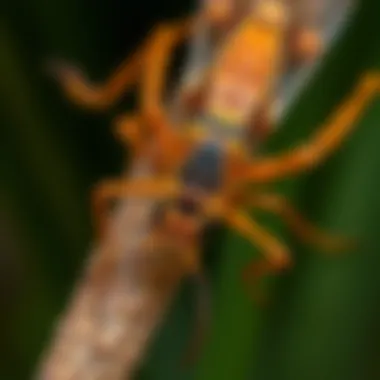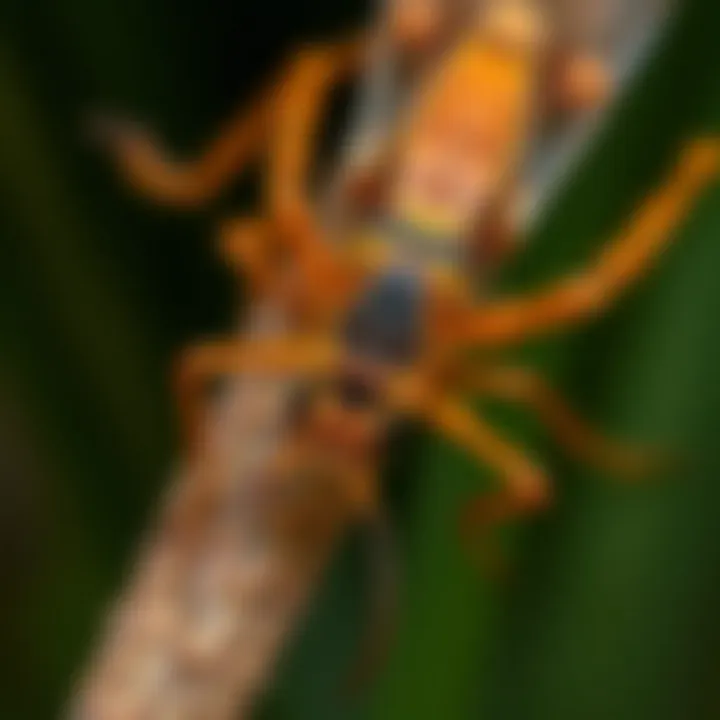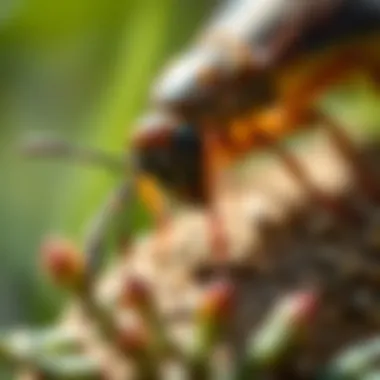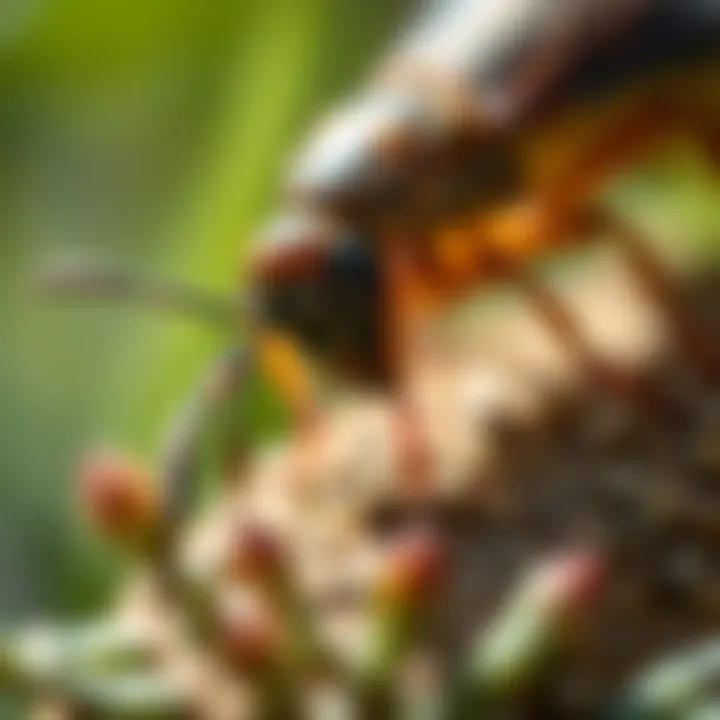Ultimate Guide to Pest Control in Santa Fe, TX


Intro
In the often verdant landscapes of Santa Fe, Texas, pests pose challenges that can affect both the beauty and health of homes and gardens. Whether you find yourself battling an army of fire ants or encountering the familiar buzz of mosquitoes around your porch, understanding pest control is crucial. This guide focuses on the pests prevalent in the area, the significance of correctly identifying them, and outlines practical, sustainable methods to keep these unwelcome intruders at bay.
Many people think of pests as merely nuisances, but there is much more beneath the surface. The relationship between humans and insects is complex, filled with ecological importance and potential hazards. Without effective pest management strategies, these creatures can wreak havoc on crops, landscapes, and human health. Thus, an informed approach is essential for anyone residing in or around Santa Fe. In exploring this topic, homeowners will be better equipped to manage their environments, ensuring a balance between natural ecosystems and living spaces that are comfortable and safe. Let's navigate through the essential aspects of pest control together, addressing topics from identification to eco-friendly practices.
Understanding Pests
Definition of Pests
Pests are organisms that cause harm or discomfort to humans, animals, crops, or the ecosystem as a whole. This includes insects like roaches and caterpillars, rodents, and even weeds that choke out desired plants. The term often conjures images of infestations, yet it is vital to recognize that not all pests are equal in terms of threat. Some might just be annoying while others can cause significant damage or pose health risks. For instance, the common house fly, while not necessarily harmful, can transport bacteria and diseases that affect food safety.
Importance of Pest Identification
Understanding what you’re dealing with is half the battle. Proper identification of pests allows for the implementation of tailored control strategies. Knowing whether that critter is a beneficial ladybug or a destructive aphid can completely change your approach to pest management. Furthermore, recognizing the signs of infestation early can prevent larger problems later. A proactive stance can save both time and money. For effective pest control, identifying the specific species of a pest often involves looking at its physical characteristics, behaviors, and the damage it causes. Here’s a quick list:
- Physical Characteristics: Size, color, and shape of the pest.
- Behavior Patterns: When are they most active? What do they feed on?
- Damage Indicators: Look for signs such as droppings, gnawing marks, or eaten foliage.
Understanding these signs is vital for creating a pest-free environment.
Prevention Techniques
Home and Garden Preventative Measures
Prevention is always better than cure, and pest control is no exception. Ensuring that your home and garden are less inviting to pests can minimize encounters significantly. Here are some tips:
- Seal Entry Points: Check screens, windows, and doors for gaps where pests could enter. Caulking or weather stripping can make a world of difference.
- Maintain Cleanliness: Regularly clean up spills, crumbs, and garbage. Pests love to feast on leftovers not cleaned up.
- Proper Waste Disposal: Make sure trash bins are secured and emptied frequently.
In the garden, practicing crop rotation and companion planting can deter pests. For instance, marigolds are often interplanted with vegetables to repel nematodes.
Seasonal Prevention Tips
Different seasons bring different pests. In Santa Fe, be mindful of the seasonal shifts:
- Spring: Start cleaning up garden debris, and consider applying barriers to prevent ants from entering your home.
- Summer: Ensure proper watering regimes that don’t create standing water, which attracts mosquitoes.
- Fall: Look for cracks in foundations where overwintering pests might enter, and seal them up.
- Winter: Keep up with the cleaning and arrange firewood neatly, as it can draw unwanted critters if left scattered.
Eco-Friendly Pest Control Solutions
Overview of Sustainable Practices
Using eco-friendly methods for pest control is not only good for the environment but can also be quite effective. Sustainable practices can include using native plants that naturally repel pests or employing microbial pest control agents that target specific species without harming beneficial insects.
Natural Remedies and Their Effectiveness
Many homeowners have turned to natural remedies that have shown promise in reducing pest populations.
- Diatomaceous Earth: A fine powder made from tiny fossilized ocean creatures that can kill insects without affecting humans or pets.
- Neem Oil: This essential oil derived from the seeds of the neem tree disrupts the lifecycle of pests, making it harder for them to reproduce.
- Here’s a quick recipe: Mix two teaspoons of neem oil with a quart of water to spray on affected plants.
Experimenting with these options can lead to a safer approach in managing pests.
"Nature does not hurry, yet everything is accomplished." - Lao Tzu
Intro to Pest Control in Santa Fe, TX
Taking care of pests is not just a chore; it’s essential for maintaining a healthy living environment. In Santa Fe, Texas, pest control holds special significance due to the area's unique climate and ecosystem. The warm weather and diverse landscapes create the perfect habitat for a multitude of pests—be it insects, rodents, or other critters that can invade homes and gardens.
Importance of Pest Control
Effective pest control plays a crucial role in safeguarding our homes from nuisances and potential health threats. For many homeowners, pests can lead to property damage, trigger allergies, or even spread diseases. Ignoring these issues can turn a small nuisance into a major headache. Gardeners, especially, need to pay close attention to pest management, as uninvited guests can ruin crops and landscapes alike. Compounding this, a keen understanding of pest behavior aids in preemptive measures, ensuring that one can nip potential infestations in the bud before they escalate.
For example, in Santa Fe, the hot and humid summer months may bring forth a surge in ant populations, and knowing this can help homeowners prepare ahead of time. Simple actions such as sealing off entry points or removing standing water can significantly reduce the chance of ant invasions.
Overview of the Pest Control Industry
The pest control industry has evolved significantly over the last few decades. Once perceived as simply applying pesticides, modern pest management encompasses a variety of approaches, often tailored to specific local environments like Santa Fe. Many pest control companies now emphasize integrated pest management (IPM), which blends biological, cultural, physical, and chemical methods to control pests while minimizing risks to people and the environment.
The industry also now recognizes the importance of eco-friendly solutions and non-chemical methods. With a rising trend toward green living, many companies offer organic products, which appeal to homeowners who are conscious about the impact of chemicals on both health and the environment. Attending local workshops or seminars on pest management can provide invaluable insights, helping homeowners stay informed about the latest trends and effective strategies.
In summary, pest control in Santa Fe is more than just a reaction to an infestation; it requires proactive measures and a holistic understanding of the local ecosystem.
"Well-informed homeowners are better equipped to deal with pests before they become a serious problem."
This guide will further explore the regional pest landscape, offering practical solutions designed to empower residents in their ongoing battle against pests.
Common Pests in Santa Fe


Understanding common pests in Santa Fe is crucial for any homeowner looking to protect their living space. The diversity of the local climate and environment creates a breeding ground for various insects and rodents. Familiarity with these pests not only helps in managing infestations but also aids in preventive measures. Homeowners who recognize the signs of pest activity are often more equipped to tackle the problem before it exacerbates.
Identification of Common Pests
In Santa Fe, a variety of pests tend to make their presence known. Recognizing these nuisances early on can save homeowners time, money, and frustration. Below are a few common pests:
- Ants: Particularly the fire ant, which can bite and cause allergic reactions.
- Termites: Silent destroyers, they can cause unseen damage to wooden structures.
- Cockroaches: Known for their resilience, cockroaches can be both a health hazard and a source of extreme discomfort.
- Rodents: Mice and rats are notorious for infesting homes, spreading disease, and damaging property.
It's pertinent for residents to know their pest adversaries. Specific features such as antennae count and body shape can aid in proper identification. For instance, fire ants are easily mistaken for other ant species, but their distinct red color and aggressive behavior set them apart.
Behavior Patterns of Local Pests
Behavior can vary widely among pests, influencing when and how they invade homes:
- Ants: These little creatures operate in colonies, often creating trails to food sources, which homeowners might notice around kitchens or trash bins.
- Termites: They typically swarm during the spring, searching for new locations to establish colonies. Damage can occur long before any visible signs appear.
- Cockroaches: Nocturnal by nature, they're more active at night, generally preferring warm, moist areas like kitchens and bathrooms.
- Rodents: These pests are opportunistic and will seek food, water, and shelter. They often nibble at wires, leading to potential fire hazards.
Understanding the behavior of these pests enables homeowners to devise strategies targeting their vulnerabilities.
Seasonal Pest Activity
The pest landscape changes with the seasons in Santa Fe. It’s vital for homeowners to adapt their strategies accordingly:
- Spring: As temperatures rise, many pests emerge from hibernation. This is when termites swarm and ants start establishing their colonies. It’s a critical time to inspect homes for vulnerabilities.
- Summer: Peak activity for ants and cockroaches occurs in mid-summer. With warmer weather, these pests become more aggressive in their search for food and shelter.
- Fall: Rodents begin seeking refuge inside homes as temperatures drop. Homeowners may see increased activity around entry points or nesting materials collected in basements and attics.
- Winter: Many pests go dormant, but it doesn’t mean they’re gone. Rodents, in particular, are more prevalent indoors during colder months, as they look for warmth and food supplies.
Keeping an eye on seasonal trends can aid homeowners in staying one step ahead of pest problems.
"Recognizing the signs of pests early can make all the difference in managing an infestation before it spirals out of control."
The End
Acknowledging common pests in Santa Fe equips homeowners with the necessary foresight to protect their habitats. Through identification, understanding behavior, and recognizing seasonal patterns, one can significantly diminish the likelihood of infestations and ensure a comfortable living space.
Effective Pest Management Strategies
Effective pest management strategies play a crucial role in maintaining not only the comfort of your home in Santa Fe but also the health of its inhabitants. Managing pests efficiently reduces the risks of property damage and health hazards while creating a harmonious living environment. There’s more to pest control than just eradicating unwanted guests; it’s about long-term solutions that also promote sustainability and ecological balance.
Integrated Pest Management (IPM)
Integrated Pest Management (IPM) is an effective approach to pest control that focuses on combining different management techniques. IPM aims to minimize the use of chemicals while maximizing prevention strategies. It is one of those nifty toolbox methods that considers the life cycle of pests, environmental conditions, and biological controls.
One key aspect of IPM is monitoring. Regular inspections help identify potential pest issues before they escalate. Using traps and visual inspections can alert homeowners to early signs of an infestation. This proactive approach often saves time, money, and effort.
Furthermore, educating yourself about the types of pests common in Santa Fe is invaluable. For instance, knowing that fire ants thrive in warmer months can help you prepare accordingly.
"An ounce of prevention is worth a pound of cure." This age-old adage rings true in pest management.
Chemical vs. Non-Chemical Methods
The debate between chemical and non-chemical methods for pest control is heating up in homes and neighborhoods. Chemical methods, usually labeled as pesticides or herbicides, can be highly effective in reducing pest populations quickly. However, you may want to take a step back and consider their long-term implications. Many homeowners are now opting for non-chemical methods that might take longer but are much safer for families and pets.
Chemical Methods Include:
- Insecticides
- Rodenticides
- Fungicides
These products are heavily regulated, and reading labels can clarify which pests they target and how to apply them safely. However, they can leave residues and potentially harm beneficial creatures.
Non-Chemical Methods Include:
- Traps and baits
- Natural repellents
- Essential oils like peppermint or clove
While chemical methods may seem to quickly eliminate pests, non-chemical alternatives are gaining popularity for their safety and effectiveness over time. Emphasizing prevention, such as sealing entry points and maintaining cleanliness, can decrease the chances of pests making themselves at home.
Emergency Response to Infestations
In case of sudden pest infestations, quick thinking is critical. Often, homeowners feel overwhelmed, but staying calm and having a plan can significantly lessen the chaos. Immediate identification of the pest at hand is paramount.
First, gather pertinent information:
- What type of pest are you dealing with?
- How many are present?
- Where are they located in the home?
Then, take initial action such as confinement of the area, preventing the pests from spreading to other parts of your home. Avoid using broad-spectrum insecticides indiscriminately; this can make the situation worse by affecting non-target species.
Calling a professional pest control service may be necessary for issues like termite infestations or widespread bedbugs. Don’t hesitate to act swiftly; procrastination often leads to exponential growth of the problem.
In summary, effective pest management is multifaceted. By understanding integrated pest management techniques, weighing the pros and cons of chemical versus non-chemical methods, and preparing for emergency situations, homeowners can ensure a safer, healthier living space. To stay updated, consider consulting resources from EPA and Texas A&M University AgriLife Extension for further information.
Eco-Friendly Pest Control Solutions


In recent years, the demand for eco-friendly pest control methods has surged, especially in places like Santa Fe, Texas. This shift is not just a trend; it's a necessary pivot towards more sustainable practices that protect the environment while effectively managing pest populations. Homeowners are increasingly aware of the consequences of chemical treatments, both on human health and the ecosystem. Thus, embracing eco-friendly solutions is paramount in cultivating a safe and nurturing living space.
The importance of utilizing eco-friendly pest control cannot be understated. By adopting natural methods, one can significantly reduce toxic runoff into the water supply, safeguard beneficial organisms, and ultimately create a safer habitat for children and pets. Moreover, these methods often incorporate natural pest deterrents and rely on the ecological principles that have stood the test of time.
Natural Pest Deterrents
Natural pest deterrents consist of a variety of substances that create an unwelcoming environment for pests without the harshness of synthetic chemicals. Essential oils, for instance, have gained popularity for their efficacy. Oils such as peppermint, clove, and eucalyptus not only repel insects but also leave a pleasant aroma.
Methods to consider when employing natural pest deterrents include:
- Diatomaceous earth, which works by dehydrating insects on contact. It's non-toxic to pets and humans, making it safe for household use.
- Garlic spray, which impairs pests' ability to smell and thus avoid plants treated with it.
- Homemade traps, such as vinegar traps for fruit flies, can deter these nuisances with just a few pantry staples.
Using these natural methods means you can keep pests at bay while being conscientious about what goes into your establishment. It's a win-win!
Beneficial Insects in Pest Management
Shifting the narrative from viewing all insects as adversaries to recognizing the allies in the insect world is crucial. Beneficial insects play a vital role in maintaining the delicate balance of ecosystems. In Santa Fe, some friendly faces are ladybugs and lacewings, both known predators of aphids and other crop-damaging pests.
Integrating beneficial insects into your pest management approach can enhance your gardening success:
- Ladybugs contribute to aphid control effectively and can be attracted by planting dill, fennel, or yarrow.
- Predatory wasps control caterpillar populations, which can devastate your garden.
- Bees and butterflies not only are pollinators—it’s essential to protect them when managing pests, as they are key to both crop yield and biodiversity.
Emphasizing a friendly coexistence with these insects not only reduces reliance on chemicals but also enriches one’s garden, leading to more vibrant plants and healthier harvests.
Organic Pest Control Products
The rise of organic pest control products offers yet another layer of protection without the environmental consequences associated with synthetic pesticides. These products are crafted using natural ingredients that are effective in controlling pest populations while being safer for the environment and human health.
Some widely used organic pest control options include:
- Neem oil, which disrupts the lifecycle of many pests while being safe for beneficial insects once dried.
- Insecticidal soap, effective for soft-bodied insects, disrupting their outer layers and leading to dehydration.
- Pyrethrin, derived from chrysanthemum flowers, targeting insects quickly without lasting toxicity to the ecosystem.
When using these products, it is essential to follow application guidelines to ensure maximum effectiveness while minimizing any potential negative effects.
In wrapping up this section on Eco-Friendly Pest Control Solutions, it’s clear that integrating natural methods not only yields effective results but also fosters a deeper connection to the environment and its ecosystems. Adopting these practices becomes a stepping stone toward responsible pest management in our cherished homes.
"Environmental responsibility is the price we must pay for a better future for our children."
For more information on organic pest control methods, check resources from the Texas A&M University Extension Service or the National Pesticide Information Retrieval System.
Homeowner's Guide to Pest Prevention
In the sunny expanse of Santa Fe, the serene atmosphere can often be interrupted by uninvited pests. This makes understanding preventive measures crucial for homeowners. Effective pest prevention not only safeguards your home but also promotes a healthier living environment for you and your family.
The importance of a proactive approach can't be overstated. Homeowners who invest in preventive strategies reduce the likelihood of severe infestations, which can escalate quickly and become costly over time. Moreover, taking steps to deter pests helps protect the structural integrity of your home and your well-being. Everyone understands that a small problem can easily mushroom into a major headache if it isn't addressed early on.
Preventative Measures Around the Home
Keeping your home pest-free often hinges on simple yet effective preventative measures. Here’s a breakdown of some key strategies:
- Seal Entry Points: Check for gaps around windows, doors, and foundations. A little caulk can work wonders.
- Maintain Cleanliness: Regularly cleaning living areas and ensuring food is properly stored can discourage pests like ants and cockroaches.
- Reduce Standing Water: Insects such as mosquitoes breed in standing water. Clear out pet bowls, clogged gutters, and plant saucers to eliminate potential breeding grounds.
- Proper Waste Disposal: Use sealed bins for trash. A clean kitchen is less appealing to unwanted guests.
- Regular Inspections: Keeping an eye out for signs of pest activity, like droppings or damage, can help catch issues before they spiral out of control.
Employing these measures creates a formidable first line of defense against potential intruders.
Gardening Tips for Pest Resistance
Gardening is a joy for many in Santa Fe, but it can also attract pests if you're not careful. To keep your garden thriving while warding off pests, consider these effective tips:
- Choose Resilient Plants: Opt for native plants that are well-suited to the climate. They attract beneficial insects and are often more resistant to pests.
- Diversity is Key: Planting a variety of species can confuse pests and reduce their chances of establishing a foothold in your garden.
- Physical Barriers: Using row covers or nets can protect young plants from bugs.
- Companion Planting: Some plants deter pests naturally. For example, marigolds are known to repel nematodes and certain beetles.
- Irregular Watering: Overwatering can lead to more pest problems. Water early in the day and ensure plants have good drainage.
Implementing such gardening strategies ensures you cultivate not only beauty but also a small fortress against pests.
"An ounce of prevention is worth a pound of cure."
By putting in place these effective home and gardening strategies, you're not just averting nuisance in your living spaces; you are fostering a more harmonious environment for everyone. Keeping pests at bay is a continuous effort, but even small, consistent actions can lead to significant results.
Professional Pest Control Services in Santa Fe
Pest control is a serious matter here in Santa Fe, where the climate can encourage a variety of unwanted visitors, from termites to ants. For homeowners looking to protect their property and inner peace, professional pest control services are not just an option; they are a necessity. Utilizing experts in this field can save time, money, and the headache of dealing with pests that can cause extensive damage. Moreover, these services are equipped with techniques and products that are often not available to the average homeowner.
The importance of choosing the right pest control company cannot be overstated. With numerous options available, it's crucial to assess their qualifications, pest control methods, and customer feedback. Also, consider whether the company offers environmentally friendly solutions. By selecting a reputable provider, homeowners can feel confident in effective pest management tailored to their specific needs.
Choosing the Right Pest Control Company
When it comes to selecting the right pest control company, you want someone who knows their stuff. Let's be honest here; some companies are more about the gimmicks than the real deal. Start by looking for companies that are licensed and insured, which indicates they follow regulations and standards in the industry. A stellar reputation is also key. Make it a point to check reviews online or get word-of-mouth recommendations from neighbors.
Consider asking potential companies questions on their approach to pest control. Some may focus on chemicals; others could prioritize prevention and natural methods. This insight can greatly influence your choice. Asking about their service guarantees can also help, ensuring you’re not left hanging if the treatment doesn’t go as planned.


Understanding Service Contracts
Before signing anything, a homeowner needs to dissect the service contract offered by the pest control company. Often, contracts can be tricky, and overlooking details can come back to bite you. Understand the terms of service, including what treatments are included, how often they'll be performed, and any associated costs. Pay close attention to the cancellation policy as well. Some contracts can lock you in longer than a commitment at a wedding if you’re not careful.
Many companies offer a mix of one-time services or ongoing maintenance plans. One might think that the ongoing plan sounds great, but ensure it fits your budget and pest situation. Are there penalties for service changes? How does the company handle pest re-occurrences between visits? These aspects are worth pondering.
Cost Considerations for Pest Control
Cost is often a sticking point for homeowners looking to rid their spaces of pests. Factors influencing your bottom line include the type of pest, the severity of the infestation, and the methods that the company uses. For example, dealing with a full-blown termite infestation isn’t going to cost the same as a simple ant problem. Here's a little breakdown of what to expect:
- Initial inspection fees: Many companies offer a free assessment, while others may charge for the consultation.
- Treatment costs: These can vary widely based on the pest in question and the treatment used. Chemical treatments can differ greatly from eco-friendly solutions.
- Follow-up visits: Maintenance programs often include follow-ups that can help keep pests at bay after the initial treatment.
Don’t shy away from getting multiple quotes. This is an excellent way to shop around and ensure you’re not getting taken for a ride. But remember, the cheapest option isn’t always the best; quality should always be a priority over price.
"Investing in pest control is investing in peace of mind. Protect your home, protect your family."
By taking the time to understand the services offered and assessing your options, you can ensure a pest-free living environment that is safe, sustainable, and tailored to your needs.
Community Resources for Pest Control
When it comes to managing pests effectively, community resources play a pivotal role. Understanding the availability and benefits of these resources can empower homeowners and residents of Santa Fe, TX, to tackle pest issues more efficiently. Community initiatives can provide necessary support in pest identification, control strategies, and preventive measures. Here, we will examine the local government initiatives and various educational programs that can help community members combat pest problems.
Local Government Initiatives
Local governments often implement initiatives aimed at pest control that benefit residents. For instance, many towns, including Santa Fe, might conduct periodic community outreach programs which include free workshops on pest management, offering practical tips for home care.
Programs such as subsidized pest control services can be instrumental for low-income families who may struggle with pest-related issues. For example, community clean-up days occasionally focus on reducing habitats for pests, like standing water for mosquitoes, thus fostering a collaborative spirit among residents.
Moreover, local agricultural departments often share vital information regarding pest outbreaks affecting crops through newsletters or alerts. This keeps everyone informed and helps to strategize a community-wide response to control infestations. Residents can also report pest-related problems to city officials, which keeps pest issues front-of-mind for policymakers. Here are a few benefits of these initiatives:
- Access to Information: Residents gain insights into local pest challenges and solutions.
- Subsidized Programs: Financial assistance for pest control can ease financial burdens.
- Community Involvement: This promotes collaboration which can have a more significant impact than individual efforts.
“When everyone pitches in, pest problems can be tackled more effectively at the neighborhood level.”
Extension Services and Educational Programs
Alongside local government initiatives, university extension services and educational programs are vital for pest control in Santa Fe. These services often provide resources, expertise, and a platform for ongoing education related to pest management. For instance, Texas A&M AgriLife Extension provides educational programs that can benefit homeowners by offering workshops on integrated pest management (IPM).
Participants learn how different pests interact within ecosystems, which helps in developing sustainable strategies rather than just exterminating pests. They also provide information on natural pest repellents and methods that can be implemented using common household items.
Additionally, the extension services typically have publications and online resources that are easily accessible. These can include guides for identifying common pests in Santa Fe or instructional materials for home gardening techniques that deter pests naturally.
Some noteworthy aspects to consider regarding extension services:
- Research-Based Information: Ensures that residents receive the latest and most effective pest management practices.
- Hands-On Workshops: These provide practical skills for managing pests effectively.
- Online Resources: A plethora of articles and guidelines available for free.
Overall, community resources for pest control in Santa Fe serve as the backbone of effective pest management strategies. Through local government initiatives and educational programs, residents are better equipped to face pest challenges head-on.
The Ecological Role of Insects
Insects often get a bad rap. People think of them mostly as pests, buzzing nuisances that invade our homes. However, insects play crucial roles in maintaining ecological balance. Understanding their ecological importance is key to recognizing their benefits and adapting more sustainable pest management strategies. The hidden contributions of insects to the ecosystems of Santa Fe not only supports biodiversity but offers invaluable services that are often overlooked.
Insects as Pollinators
Pollination is one of the most significant tasks performed by insects, and it’s crucial for agriculture and natural plant communities. Almost 75% of the world's flowering plants rely on other living creatures for pollination, and insects are the primary players. Bees, butterflies, and even certain beetles contribute to ensuring plants reproduce effectively.
- Different Types of Pollinators: While honeybees are perhaps the most well-known pollinators, local species like native bees, wasps, and butterflies also play a vital role. These insects have evolved unique relationships with different plants, and their decline could spell disaster for many crops.
- Economic Impact: In Santa Fe, the agricultural sector benefits immensely from insect pollinators. The produce that makes it to local markets depends on these insects. Loss of pollinator populations could directly affect local economies and food supplies.
"Healthy ecosystems rely on the intricate dance between plants and pollinators; without them, we could face a future of barren fields and empty tables."
Decomposers and Their Importance
Another often-overlooked role that insects fulfill is that of decomposers. Decomposing insects, primarily dung beetles, ants, and certain larvae, help to break down organic matter, such as dead plants and animals. This process is vital for nutrient cycling within the ecosystem.
- Nutrient Recycling: By breaking down organic waste, these insects convert it back into nutrients that plants can absorb. Without them, ecosystems would accumulate dead material and nutrient deficiencies would arise, affecting soil health.
- Soil Aeration: The actions of these insects also aerate the soil, promoting better water retention and enhancing plant growth. This is particularly important in regions like Santa Fe, where water can be scarce and maintaining healthy soil is crucial for agriculture.
- Reducing Disease Transmission: Decomposers help limit the spread of disease by efficiently eliminating dead organic matter that could harbor pathogens. Without addressing these dead and decaying materials rapidly, insect populations could proliferate, leading to outbreaks of diseases.
In summary, appreciating the multifaceted roles insects play in our ecosystems leads to more profound insights into pest management strategies. Rather than viewing insects solely as a nuisance, understanding their vital functions can help foster a more harmonious relationship between humans and the environment. This understanding is particularly crucial for homeowners looking to embrace solutions that are not just effective, but also sustainable.
Culmination
As we come to the end of this exploration into pest control in Santa Fe, it’s important to reflect on the themes and insights that have unfolded. Understanding pest management is not merely about dealing with unwanted critters; it’s about safeguarding our homes and health. With the right strategies and knowledge, homeowners can mitigate potential infestations and ensure their living spaces remain comfortable and safe.
One of the key insights from this guide is the significance of preventative measures. A proactive approach not only reduces the risk of an infestation but also minimizes the reliance on chemical treatments, creating a healthier environment. Awareness of the local pest population and their behaviors helps homeowners make informed decisions, ensuring that they tackle problems at their root rather than just addressing symptoms.
"An ounce of prevention is worth a pound of cure."
In addition, eco-friendly solutions highlighted throughout the article represent a growing trend as people become more conscious of their ecological footprint. Utilizing natural deterrents and promoting beneficial insects can maintain balance in our gardens and homes. This shift reflects a broader movement towards sustainability, where we learn to live alongside nature instead of against it.
The knowledge shared in this guide encourages an ongoing dialogue. Homeowners are encouraged to take an active role in their pest management decisions, exploring local resources and community initiatives that support pest control efforts. The tools and strategies discussed here can empower individuals to take the reins in their pest control journeys.
As we step into the future, it becomes clear that pest control is evolving. Developing technologies and methodologies promise to enhance efficiency and effectiveness in managing pests. As homeowners in Santa Fe, keeping an eye on these trends can provide additional insights and tools to maintain a pest-free haven.
Ultimately, investing time in understanding pest control is not only beneficial but necessary. The stakes are high as we protect our health, our families, and our cherished possessions. Embracing the knowledge shared in this article will hopefully inspire confident action against pests in your home.



